Dice: Meaning, Reasoning Questions and Answers, Examples
Imagine a standard cube numbered 1 to 6, and you are asked to determine which number appears opposite to 3. Such problems test your ability to visualize and analyze the structure of a cube. In this article, we will explore the basic definition of dice in logical reasoning, solve easy-to-advanced examples, and discuss the different types of questions you can expect. Dice questions frequently appear in competitive exams such as SSC, RRB, Bank PO, NDA, CDS, State PSCs, and various aptitude tests.
This Story also Contains
- Introduction to Dice Folding in Reasoning
- Types of Questions Based on Dice Reasoning
- Recommended Books and Online Resources for Dice Reasoning
- Practice Questions For Opposite Faces in Dice-Based Questions
- Practice Questions For Unfolded Dice-Based Questions
- Non-Verbal Reasoning Topics
- Tips to Approach Some Tricky Questions Based on Unfolded Dice Reasoning
- Dice Reasoning Questions for VITEEE Exam
- Dice Reasoning Questions for SSC CGL/ SSC CHSL/ SSC CPO/ SSC Stenographer Exams
- Dice Reasoning Questions for Defence/ Railway Recruitment Board Exams
- Tricks to Solve Dice and Cube Questions for SSC

Introduction to Dice Folding in Reasoning
Dice folding is an important topic in logical reasoning, where candidates learn how to visualize a flat unfolded dice (net) and determine its folded form. These questions often test a candidate’s ability to think spatially and mentally rotate objects. Whether it’s for SSC, banking, or other government exams, mastering dice in reasoning helps improve both speed and accuracy.
What is Dice Folding?
Dice folding refers to the process of understanding how a 2D net of a dice transforms into its 3D form. In open dice questions, the sides are shown unfolded, and the task is to figure out the arrangement when folded. This is a core part of dice topic of reasoning, where practice on dice reasoning questions improves mental visualization skills.
Importance of Dice Folding Questions in Logical Reasoning
In competitive exams, dice reasoning questions often appear alongside cube reasoning problems. They evaluate a candidate’s logical thinking, pattern recognition, and spatial understanding. Solving dice and cube questions for SSC and other exams also sharpens problem-solving strategies for puzzles and spatial reasoning sections.
Role of Dice and Cube Questions in Competitive Exams
Dice questions for SSC, banking, and railways exams frequently assess how well candidates can interpret 3D structures from 2D patterns. These problems, often provided in dice reasoning questions, SSC practice sets, are considered high-scoring if prepared well. They also serve as a foundation for solving related topics like paper folding and mirror image reasoning.
Types of Questions Based on Dice Reasoning
Different types of questions asked from the dice reasoning are as follows -
Opposite face in Dice-based questions
Unfolded dice-based questions
Let’s understand these types with the help of examples of dice reasoning questions:
1. Opposite Face in Dice-Based Questions
In these types of questions, one has to determine the pair of opposite faces of the given die based on its different positions. There are further rules to solve these types of problems. Let’s analyse different types of rules with the help of examples.
Rule 1: When 2 different positions of a dice are given with one common number on the same surface. then, the remaining faces containing different numbers on the same surface are the opposite faces. Let’s understand the case with the help of an example -
Example: In the diagram given below, the face containing 2 is common in both the dice and it is on the same surface. Let’s analyse the conclusions based on the above rule.

Now, considering both the positions of a die, we can see that the common face is 2 and is on the same surface. So, the opposite face to the face containing 3 and 6 is 1, and 4 respectively.
Rule 2: When two positions of the same dice are given with two common faces but in different orientations, then out of those two common faces, the faces that are not common are opposite to each other. Let’s understand the case with the help of an example -
Example: Consider the following diagram, two positions of a dice are given with two common faces.
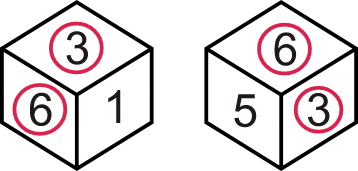
Now, in the above diagram, we can see that the faces containing 6 and 3 are the common faces, and 1 and 5 are the remaining faces. So, the faces containing 1 and 5 are the opposite faces.
Rule 3: When two positions of the same dice are given with one common face but in different orientations, then start moving in the clockwise direction from one face to the other, (starting from the common face), we will get the pair of opposite faces. Let’s understand the case with the help of an example -
Example: The figure given below shows two different positions of a dice with one face common and in different orientations. (Let us assume that the sixth face of the dice is 3.)
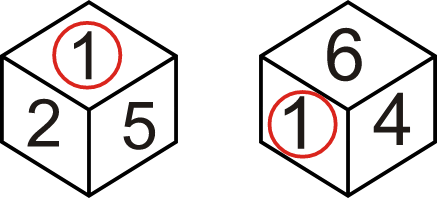
Now, to determine the pair of opposite faces, move in the clockwise direction, starting from the common face, 1. As we move in the clockwise direction from 1, in the first dice the next number is 5 and in the second dice, it is 6. So, 5 and 6 are the opposite faces. Similarly, on moving further in the same direction, the next number in the first dice is 2 and in the second dice, it is 4. So, 4 and 6 are the opposite faces.
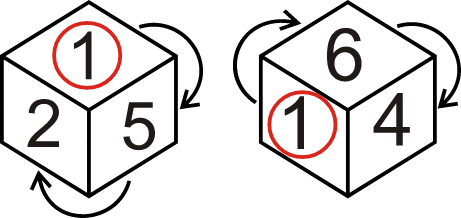
So, the pair of opposite faces are - (5⇔6); (2⇔4); (1⇔3).
2. Unfolded Dice-Based Questions
These types of questions are based on an open dice. In an open dice, all the six faces of the dice are visible. It is a flat-end version of a 3-D dice. The faces of an open die are folded to form a 3-D version of the dice. In an open dice, alternate faces form the pair of opposite faces and no two opposite faces touch each other either by sides or by corners. Let’s understand this with the help of an example.
Example: An unfolded version of a dice is given below. Determine the pairs of opposite faces as well as the 3-D view of dice that can be formed by folding the given sheet from the given options.
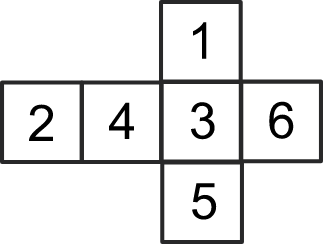
A) 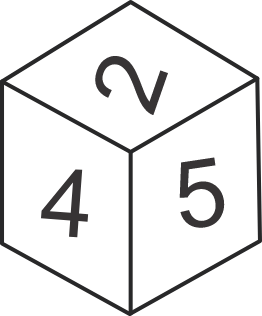 B)
B) 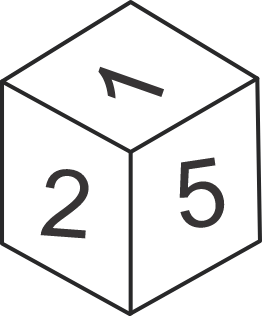 C)
C) 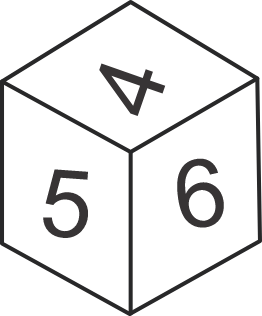 D)
D) 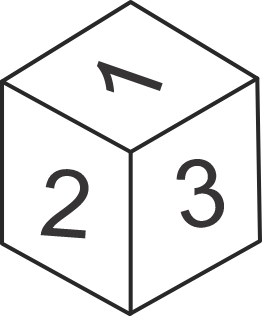
As explained above, alternate faces are the opposite faces. So, here, (3, 2); (6, 1); and (5, 4) are the alternate as well as opposite faces as shown below:

Pairs of opposite faces – (2⇔3), (4⇔6), (1⇔5)
So, in the 3-D view of dice, each face out of three faces in the 3-D view should be from each pair. Two opposite faces cannot appear adjacently in the 3-D view of the dice. As per the above diagram and rules, only option (A) is possible. Because in all other options, opposite faces appear adjacently.
Recommended Books and Online Resources for Dice Reasoning
1. A Modern Approach to Verbal & Non-Verbal Reasoning by R.S. Aggarwal
2. SSC Reasoning by Rakesh Yadav
3. The candidates must practice dice reasoning questions and answers pdf , open dice reasoning questions pdf , dice reasoning questions pdf available online to ace the topic dice.
Question Weightage of Dice Reasoning in Competitive Exams
The number of questions based on dice varies from exam to exam -
1) Questions asked in exams SSC i.e. SSC MTS, SSC CHSL, SSC CGL, SSC CPO, Steno - 2 to 3 questions.
2) Questions asked in the RRB exam i.e. RRB Group D, NTPC, JE, ALP etc - 2 to 3 questions.
3) Questions asked in entrance exams i.e. VITEEE, CUET etc - 1 to 2 questions.
Practice Questions For Opposite Faces in Dice-Based Questions
Q1. Directions: Two different positions of the same dice are shown (figures 1 and 2). Find the number on the face opposite to the face having 3.

A) 3
B) 6 (Correct)
C) 5
D) 4
Solution: According to the dice rule, if two or three positions of the same dice are given with two common faces but in different orientations, then out of those two common faces the faces that are not common are opposite to each other.
While considering the given Figures 1 and 2, it is seen that two faces 4 and 2 are common. So, the remaining numbers are 3 and 6. So, 3 and 6 are the opposite faces of each other in the given dice.
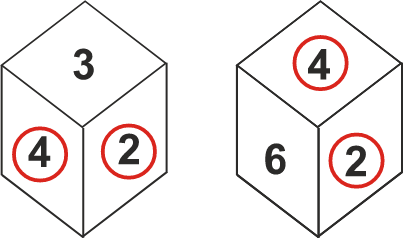
Therefore, the opposite face of 3 is 6. Hence, the second option is correct.
Q2. Directions: Two different positions of the same dice are shown. Select the letter that will be on the face opposite to the one having A.

A) B
B) F
C) N
D) Z (Correct)
Solution: Two different positions of a dice are given with one face common, ‘Z’ and the sixth face is A. So, move in the clockwise direction from the common face Z as shown below to get the opposite pair of faces.
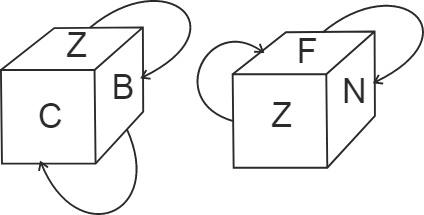
So, the pair of opposite faces - (B⇔F); (C⇔N); (Z⇔A).
Therefore, the opposite face of the A is Z. Hence, the fourth option is correct.
Q3. Directions: Two positions of a dice are given below. What will come on the face opposite to the face containing R on it?
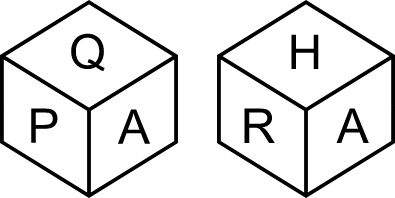
A) Q
B) P (Correct)
C) A
D) H
Solution: Two different positions of a dice are given with one face common, ‘A’ and assume that the sixth face is B. So, move in the clockwise direction from the common face A as shown below to get the opposite pair of faces.
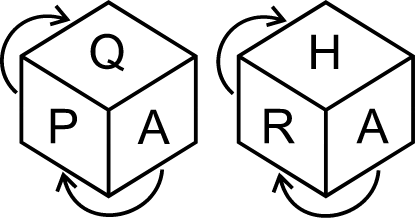
So, the pair of opposite faces - (P⇔R); (Q⇔H); (A⇔B).
Therefore, the opposite face of the R is P. Hence, the second option is correct.
Q4. Directions: Three different positions of the same dice are shown. Find the number on the face opposite to the one having 8.

A) 3
B) 1
C) 6 (Correct)
D) 5
Solution: According to the dice rule, if two or three positions of the same dice are given with two common faces but in different orientations, then out of those two common faces the faces that are not common are opposite to each other.
While considering Figures 1 and 3, it is seen that two faces 7 and 3 are common. So, the remaining numbers are 8 and 6. So, 8 and 6 are the opposite faces of each other in the given dice.
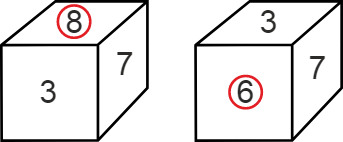
Therefore, the opposite face of 8 is 6. Hence, the third option is correct.
Q5. Directions: Two dimensions of the same dice are given. What letter will be on the face opposite to the face having the letter F?

A) B (Correct)
B) D
C) C
D) A
Solution: Two different positions of a dice are given with one face common, ‘B’ and the sixth face is F. So, move in the clockwise direction from the common face B as shown below to get the opposite pair of faces.
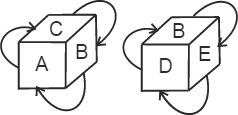
So, the pair of opposite faces - (A⇔E); (C⇔D); (B⇔F).
Therefore, the opposite face to the face containing F is B. Hence, the first option is correct.
Practice Questions For Unfolded Dice-Based Questions
Q1. Directions: An unfolded version of a dice is given below. Determine the pairs of opposite faces of the given dice.
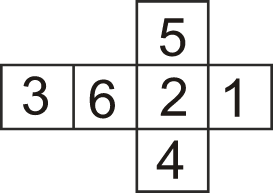
A) (2⇔3), (4⇔6), (1⇔5)
B) (2⇔5), (4⇔6), (3⇔1)
C) (2⇔3), (1⇔6), (4⇔5) (Correct)
D) (5⇔3), (4⇔2), (6⇔5)
Solution: According to the rules, alternate faces are the opposite faces. So, here, (3, 2); (6, 1); and (5, 4) are the alternate as well as opposite faces as shown below:
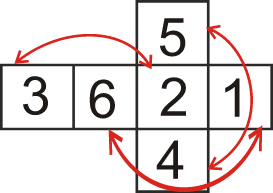
So, the pairs of opposite faces – (2⇔3), (4⇔6), (1⇔5). Hence, the third option is correct.
Q2. Directions: An unfolded version of a dice is given below. What letter will be on the face opposite to the face having the letter C?

A) F
B) A
C) B
D) E (Correct)
Solution: According to the rules, alternate faces are the opposite faces and no two opposite faces touch each other. So, here, (B, A); (D, F); and (C, E) are the alternate as well as opposite faces as shown below:
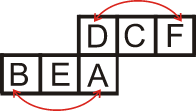
So, the pairs of opposite faces – (B⇔A), (D⇔F), (C⇔E).
Therefore, the opposite face of C is E. Hence, the fourth option is correct.
Q3. Directions: A cube is made by folding the given sheet. In the cube so formed, which number letter will be on the face opposite to the face showing 7?

A) A
B) 4 (Correct)
C) 6
D) 8
Solution: According to the rules, alternate faces are the opposite faces and no two opposite faces touch each other. So, here, (8, 9); (7, 4); and (6, A) are the alternate as well as opposite faces as shown below:
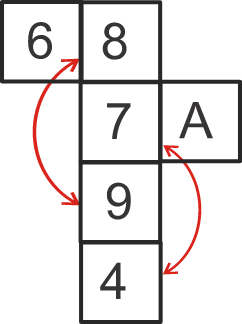
So, the pairs of opposite faces – (8⇔9), (7⇔4), (6⇔A).
Therefore, the opposite face of 7 is 4. Hence, the second option is correct.
Q4. Directions: By folding the given paper, which of the following boxes can be made?
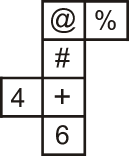
A)  B)
B)  C)
C)  D)
D)  (Correct)
(Correct)
Solution: According to the rules, alternate faces are the opposite faces and no two opposite faces touch each other. So, here, (@, +); (#, 6); and (4, %) are the alternate as well as opposite faces as shown below:
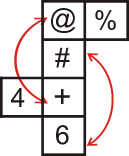
So, the pairs of opposite faces – (@⇔+); (#⇔6); and (4⇔%).
So, in the 3-D view of dice, each face out of three faces in the 3-D view should be from each pair. Two opposite faces cannot appear adjacently in the 3-D view of the dice. As per the above diagram and rules, only option (D) is possible. Because in all other options, opposite faces appear adjacently.
So, as per the above diagram and rules, the below figure can be formed.

Hence, the fourth option is correct.
Q5. Directions: A cube is made by folding the given sheet. In the cube so formed, which number letter will be on the face opposite to the face showing 4?
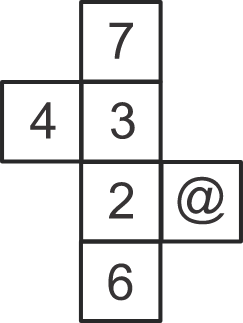
A) 7
B) 2
C) 6
D) @ (Correct)
Solution: According to the rules, alternate faces are the opposite faces and no two opposite faces touch each other. So, here, (7, 2); (3, 6); and (4, @) are the alternate as well as opposite faces as shown below:

So, the pairs of opposite faces – (7⇔2), (3⇔6), (4⇔@).
Therefore, the opposite face of 4 is @. Hence, the fourth option is correct.
Non-Verbal Reasoning Topics
The candidates who are preparing for the upcoming entrance and Government exams can also refer to the links given below and master the non-verbal reasoning ability section:
Tips to Approach Some Tricky Questions Based on Unfolded Dice Reasoning
The questions related to unfolded dice are solved according to the above-mentioned rules. As in the above example, only one 3-D view of dice is possible from the given options. But, in several cases, more than one 3-D view of a dice can be possible. In that case, we need to thoroughly check which of the views is correct. For this, we need to compare all the possible cases.
Q1. Directions: Which of the following cubes in the answer figure cannot be made based on the unfolded cube in the question?

A)  B)
B)  C)
C)  D)
D)  (Correct)
(Correct)
Solution: According to the rules and the properties of dice, opposite faces of the dice cannot appear adjacently and the sides of the opposite faces cannot touch each other. In the unfolded dice, alternate faces are the opposite faces. So, according to the above figure, the pairs of opposite faces are as follows:
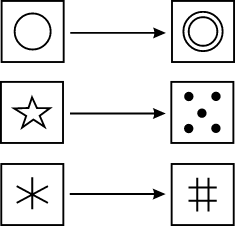
According to the above figure and rules discussed above, all the given dice in the options can be formed. But if we compare the fourth option with the other options, the fourth option gives the different opposite faces. So, from this, it can be concluded that the position of the dice given in the fourth option is incorrect. Thus, the image in the fourth option cannot be formed by folding the dice.
Hence, the fourth option is correct.
Q2. Directions: Which of the following cubes in the answer figure cannot be made based on the unfolded cube in the question figure?
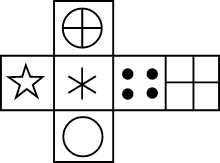
A)  B)
B)  C)
C)  D)
D)  (Correct)
(Correct)
Solution: According to the rules and the properties of dice, opposite faces of the dice cannot appear adjacently and the sides of the opposite faces cannot touch each other. In the unfolded dice, alternate faces are the opposite faces. So, according to the above figure, the pairs of opposite faces are as follows:

According to the above figure and rules discussed above, all the given dice in the options can be formed. But if we compare the fourth option with the other options, the fourth option gives the different opposite faces. So, from this, it can be concluded that the position of the dice given in the fourth option is incorrect. Thus, the image in the fourth option cannot be formed by folding the dice.
Hence, the fourth option is correct.
Q3. Directions: Which of the following cubes in the answer figure cannot be made based on the unfolded cube in the question figure?
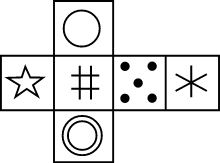
A)  B)
B)  (Correct) C)
(Correct) C)  D)
D) 
Solution: According to the rules and the properties of dice, opposite faces of the dice cannot appear adjacently and the sides of the opposite faces cannot touch each other. In the unfolded dice, alternate faces are the opposite faces. So, according to the above figure, the pairs of opposite faces are as follows:
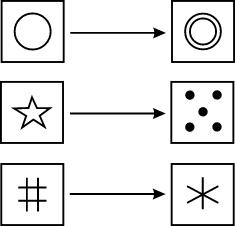
According to the above figure and rules discussed above, all the given dice in the options can be formed. But if we compare the second option with the other options, the second option gives the different opposite faces. So, from this, it can be concluded that the position of the dice given in the second option is incorrect. Thus, the image in the second option cannot be formed by folding the dice.
Hence, the second option is correct.
Dice Reasoning Questions for VITEEE Exam
1) Directions: From the given options, which answer figure can be formed by folding the figure given in the question?
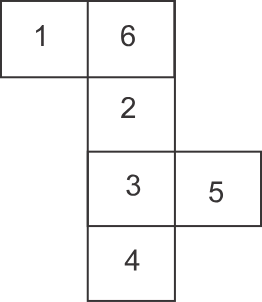
1)
2)
3)
4)
Hint: Find the opposite pair of faces and choose the correct figure by comparing those opposite faces.
Solution
In a 3D view of dice,
1. Each face out of the three faces in the 3D view should be from all the pairs.
2. Two opposite faces cannot appear adjacently in the 3D view of a folded cube figure. So, the opposite pairs of faces are as follows –

Based on the above diagram and rules, the following image can be formed –

Hence, the first option is correct.
2) Directions: Which of the following cubes in the answer figure cannot be made based on the unfolded cube in the question figure?
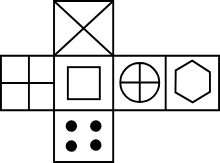
1)
2)
3)
4)
Solution
Properties of a dice –
1. Opposite faces of a dice cannot appear or hide together.
2. Sides of the opposite faces of a dice cannot touch each other.
Rules to find out the opposite faces of a dice when two or more positions of the same dice are given –
1. When one face is common: Rotate the faces of one of the given positions of a dice clock/anti-clockwise starting from the common face. Countering faces in this process will be opposite faces.
2. When two faces are common: The remaining faces are opposite faces after the two common faces of a dice.
Opposite faces of the given unfolded dice after folding it –
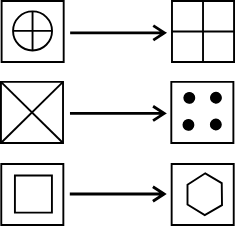
Now, as per the properties of dice, all the given dice in the options can be formed but by the first rule of the dice (given above), the dice given in the first option give different opposite faces of the same dice after comparing it with another position of the same dice given in the other three options. So, the dice in the first option cannot be formed after folding the given dice.

Hence, the first option is correct.
Dice Reasoning Questions for SSC CGL/ SSC CHSL/ SSC CPO/ SSC Stenographer Exams
1) Directions: Three positions of a cube are shown below. What will come opposite to face containing 1?

1) 2
2) 3
3) 4
4) 6
Solution
Taking dice positions 2 and 3 with 1 as common face,

Moving clockwise from the common face with 1,

Pairs of opposite faces –
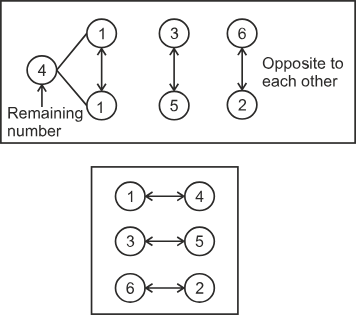
The opposite face to the one with 1 is 4. Hence, the third option is correct.
2) Directions: From the given options, which option figure can be formed by folding the figure given in the question figure?
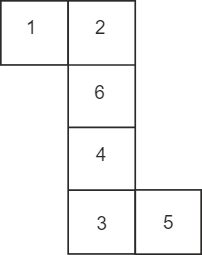
1)
2)
3)
4)
Solution
In a 3D view of dice,
1. Each face out of the three faces in the 3D view should be from all the pairs.
2. Two opposite faces cannot appear adjacently in the 3D view of a folded cube figure. So, the opposite pairs of faces are as follows –
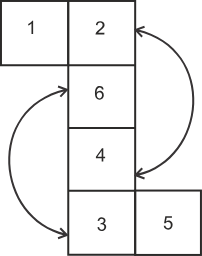
(2 ⇔ 4), (6 ⇔ 3), (1 ⇔ 5) are the opposite pairs of faces.
Thus,
 is possible and will be formed by folding the dice. Hence, the third option is correct.
is possible and will be formed by folding the dice. Hence, the third option is correct.
Dice Reasoning Questions for Defence/ Railway Recruitment Board Exams
1) Directions: Three positions of a cube are shown below:

What will come on the two faces marked 1 and 2?

1) θ and δ
2) α and β
3) θ and β
4) θ and γ
Solution
Taking dice positions 1 and 3 with α as the common face. So, on moving in the clockwise direction from α, the following opposite pairs of faces will be formed –
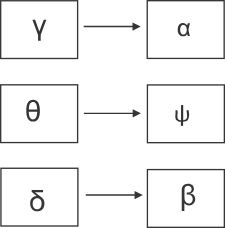
As per the properties of the dice, the opposite faces of a dice cannot appear together and the sides of opposite faces cannot touch each other.
So, the opposite face of Ψ is θ, i.e., θ will not be the adjacent face of the one containing Ψ.
In the first, third, and fourth options θ is present, so those cannot be considered as the adjacent faces of Ψ. Therefore, based on the above diagram and rules, the following image can be formed –

On comparing the diagrams, we get 1 = α and 2 = β. Hence, the second option is correct.
2) Directions: Two different positions of the same dice are shown. Identify the letter on the face opposite the face showing X.
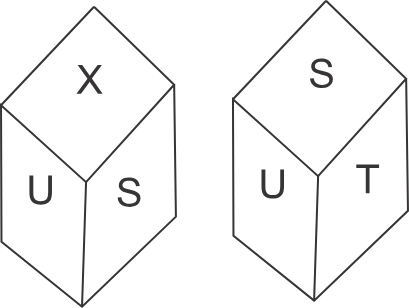
1) W
2) S
3) V
4) T
Solution
According to the dice rule, if two or three positions of the same dice are given with two common faces but in different orientations, then out of those two common faces the faces that are not common are opposite to each other.
In the given dice, two faces S and U are common. So, the remaining letters on the dice are X and T. So, X and T are the opposite faces of each other in the given dice.

So, the opposite face to the face containing X is T. Hence, the fourth option is correct.
Tricks to Solve Dice and Cube Questions for SSC
Dice and cube questions in reasoning are a common part of SSC exams, testing both analytical skills and speed. Mastering these questions helps in scoring quickly, especially when time is limited. Knowing simple tricks for opposite face identification, handling open dice patterns, and applying quick folding techniques can make problem-solving much easier. Below are some of the most effective methods to solve dice and cube questions for SSC.
Quick Methods for Opposite Face Identification
In dice folding questions, one of the most common tasks is identifying the opposite faces of a dice. In competitive exams like SSC, CGL, CHSL, and other government tests, this can be a time-consuming step if you do not know the technique. A simple trick is to look for faces that never appear together in any diagram of the dice in reasoning question. Mastering this identification helps you solve both dice reasoning questions, SSC practice sets and live exam problems faster.
Shortcut for Solving Open Dice Questions
Open dice questions require mentally folding a flat net of a dice into a 3D cube. A quick approach is to visualise the center square as the top face and then wrap the side faces around it, checking for adjacent and opposite face placements. Regularly practicing dice topic of reasoning through SSC-specific materials can make this process second nature, ensuring you don’t waste time during the exam.
Time-Saving Tips for Dice Folding in Exams
For high-speed accuracy in dice and cube questions for SSC, focus on pattern recognition. Memorise common dice nets, use elimination for wrong options, and always verify the position of numbers or symbols quickly. Using dice reasoning questions for timed practice will build your mental agility. The more you practice, the faster you can spot the correct answer without overthinking in the exam hall.
About the Faculty
Tanu Gupta, with over a decade of experience as a reasoning faculty, specializes in preparing students for various entrance examinations and career development. Her extensive work with multiple educational platforms and institutions has honed her expertise in logical and analytical thinking. Her dedication to innovative teaching methods ensures these articles provide practical insights and expert guidance.
Frequently Asked Questions (FAQs)
The questions related to dice are asked in various competitive exams such as SSC, Bank PO, Bank Clerk, Railway, Defence, UPSC, State PCS, etc.
The level of the questions of the dice has been seen as easy to moderate in the examinations.
There are many relevant books where questions related to dice can easily be found. Also, there are some online sources where you can apply the mock exams to practice the questions.
No, there is no short trick to solve the question based on dice. Just remember the rules and properties of dice to solve such questions.
Dice in reasoning are defined as cubes with specific digits on each side. The numbers are generally one digit which ranges from 1 to 6.
1) When 2 different positions of a dice are given with one common number on the same surface. then, the remaining faces containing different numbers on the same surface are the opposite faces.
2) When two positions of the same dice are given with two common faces but in different orientations, then out of those two common faces, the faces that are not common are opposite to each other.
3) When two positions of the same dice are given with one common face but in different orientations, then start moving in the clockwise direction from one face to the other, (starting from the common face), we will get the pair of opposite faces. For better understanding you may read the above article as the rules and formula are explained with examples.